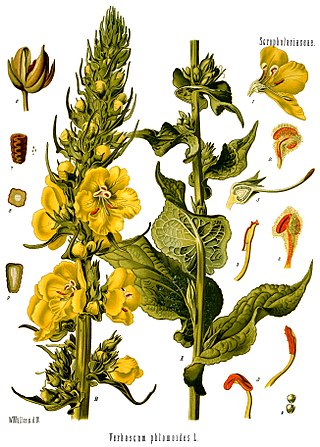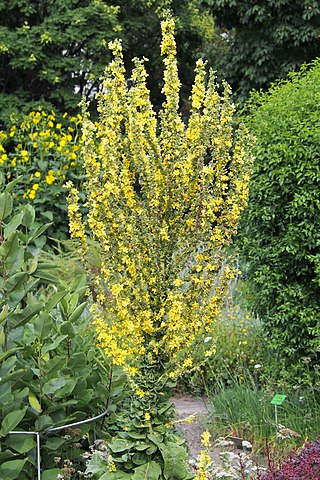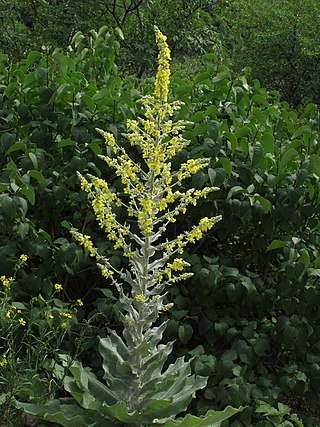
The Scrophulariaceae are a family of flowering plants, commonly known as the figwort family. The plants are annual and perennial herbs, as well as shrubs. Flowers have bilateral (zygomorphic) or rarely radial (actinomorphic) symmetry. The Scrophulariaceae have a cosmopolitan distribution, with the majority found in temperate areas, including tropical mountains. The family name is based on the name of the included genus Scrophularia L.

Verbascum is a genus of over 450 species of flowering plants, common name mullein, in the figwort family Scrophulariaceae. They are native to Europe and Asia, with the highest species diversity in the Mediterranean.

Verbascum thapsus, the great mullein, greater mullein or common mullein, is a species of mullein native to Europe, northern Africa, and Asia, and introduced in the Americas and Australia.
The soil seed bank is the natural storage of seeds, often dormant, within the soil of most ecosystems. The study of soil seed banks started in 1859 when Charles Darwin observed the emergence of seedlings using soil samples from the bottom of a lake. The first scientific paper on the subject was published in 1882 and reported on the occurrence of seeds at different soil depths. Weed seed banks have been studied intensely in agricultural science because of their important economic impacts; other fields interested in soil seed banks include forest regeneration and restoration ecology.

Verbascum blattaria, the moth mullein, is a flowering biennial plant belonging to the figwort family Scrophulariaceae. A native of Eurasia and North Africa, it has naturalized in the United States and most of Canada since its introduction and has become an invasive species there. It has been declared a noxious weed by the state of Colorado.

Verbascum nigrum, the black mullein or dark mullein, is a species of biennial or short-lived perennial herbaceous plant in the mullein genus Verbascum, native to dry open sites in temperate Europe. It grows to 0.5–1.5 m (1.6–4.9 ft).

Verbascum densiflorum, also known as denseflower mullein and dense-flowered mullein, is a species of plant in the figwort family Scrophulariaceae.

Verbascum speciosum is a species of flowering plant in the figwort family known by the common name Hungarian mullein or showy mullein. It is native to eastern Europe and western Asia, and it is known in many other regions as an introduced species and roadside weed. It is a biennial herb forming a rosette of large leaves and an erect stem well exceeding one meter in maximum height. The leaves are 30 to 40 centimeters long and have smooth edges and pointed tips. The plant blooms in a large panicle with many branches lined with flowers. Each flower has a corolla measuring 2 to 3 centimeters wide with five yellow petals. There are five stamens coated in long white hairs at the center. The fruit is a capsule up to 7 millimeters in length containing many seeds.

Verbascum phoeniceum, known as purple mullein, is a species of mullein that is part of the family Scrophulariaceae native to Central Europe, Central Asia and Western China. It is also naturalized in certain regions of the US and Canada. It successfully grows in USDA’s zones 4 to 8. It is a short-lived perennial species, and blooms earlier than other mullein species on average, producing vibrant purple-pink flowers; it can grow up to 1m or more.
Dicyphus hesperus is a species of true bug in the family Miridae. It is a generalist predator of other insects and also feeds on plant tissues. It is native to North America and has been used there in biological control of agricultural pests, especially whitefly on tomatoes.

Verbascum phlomoides, the orange mullein, woolly mullein, or clasping-leaf mullein, is a plant species in the family Scrophulariaceae native to Europe and Asia Minor. It is a widespread weed in North America. The Royal Horticultural Society considered it to be a good plant to attract pollinators. It is used as a respiratory catarrh and diuretic.

Verbascum sinuatum, commonly known as the scallop-leaved mullein, the wavyleaf mullein, or Candela regia, is a species of perennial herbaceous plants in the genus Verbascum (mullein), growing in heavy soils in Central Asia and the Mediterranean region. It grows to 1.2–1.5 m (3.9–4.9 ft). The plant has an erect inflorescence stem, and is entirely covered with stellate hairs (trichomes) which are not pleasant to the touch.

Verbascum chaixii, the nettle-leaved mullein, is a species of flowering plant in the genus Verbascum, native to Spain, France, Italy, the former Yugoslavia, and Greece. It is considered a good plant to attract pollinators. With Verbascum bombyciferum it is a parent of the 'Pink Domino' cultivar, which has gained the Royal Horticultural Society's Award of Garden Merit.

Verbascum bombyciferum, called the giant silver mullein, Turkish mullein and Broussa mullein, is a species of flowering plant in the genus Verbascum, native to Turkey, and introduced to California, Great Britain and Germany. It is considered a good plant to attract pollinators. With Verbascum chaixii it is a parent of the 'Pink Domino' cultivar, which has gained the Royal Horticultural Society's Award of Garden Merit.

Verbascum epixanthinum, the yellow mullein, is a species of flowering plant in the family Scrophulariacee, native to Greece. Growing to 1 m (3.3 ft) tall, it is an erect herbaceous perennial with grey-green leaves, and dense 70 cm (28 in) spikes of yellow flowers in summer. Though perennial, it may be short-lived.

Verbascum lychnitis, the white mullein, is a flowering plant in the figwort family (Scrophulariaceae) native to Asia and Europe. It has naturalized in parts of North America. The species was first formally named by Carl Linnaeus in 1753. Despite its common name, the flowers can be white or yellow.

Verbascum olympicum, the Greek mullein, Olympian mullein or Olympic mullein, is a species of flowering plant in the family Scrophulariaceae, native to northwest Turkey. A short-lived perennial reaching 2 m, the Royal Horticultural Society considers it a good plant to attract pollinators.

Verbascum pulverulentum, the hoary mullein or broad-leaf mullein, is a species of flowering plant in the family Scrophulariaceae. It is native to central and southern Europe, and has been introduced to Austria, Madeira, and Washington state in the US. It is a specialist on coastal shingle, and so is preadapted to human-influenced habitats such as old quarries and gravel pits, road verges, railway embankments, and similar disturbed stony ground.

Verbascum boerhavii, the annual mullein, is a species of flowering plant in the family Scrophulariaceae, native to Spain, France, and Italy. It has been traditionally used as a treatment for haemorrhoids. It contains the phenylpropanoid glycoside poliumoside, which has an affinity for metalloproteinases.

Verbascum creticum is a species of plants in the family Scrophulariaceae.


















